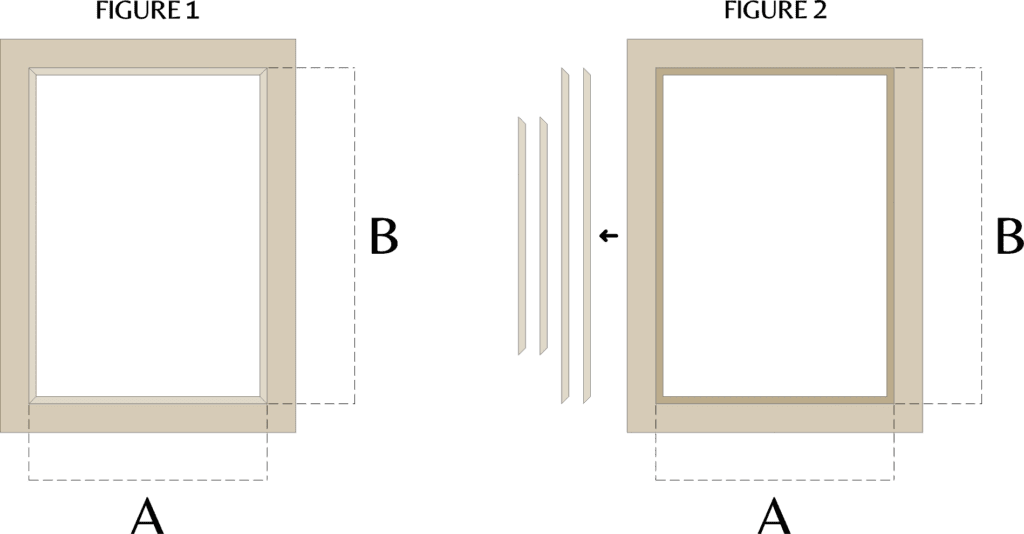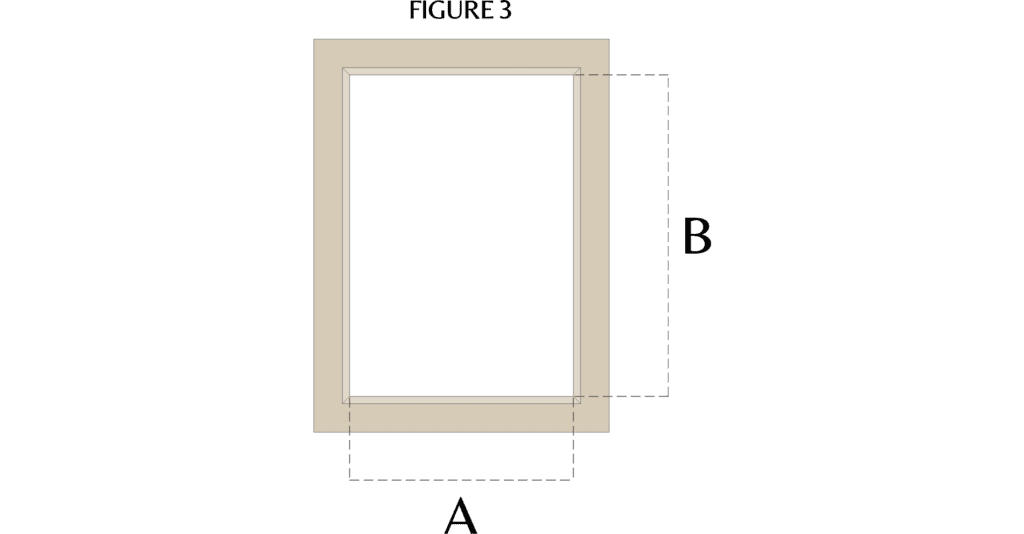A Guide
Measuring Glass
When ordering new glass or replacement glass for a door or window, if you haven’t had to measure glass sizes before, the process can seem scary, but it needn’t be. Our guide below will explain how to measure glass sizes in just a few short steps to get you on your way to ordering some beautiful Etched Glass or Fused Glass for your home.
But first, you should consider whether or not you actually need to measure yourself. If somebody else will be fitting your glass when it arrives like a glazier, you may want to get them to measure up for you. That way you have the peace of mind that a glazing professional has provided your glass sizes. If you’re looking to buy glass for a new door you’ve purchased, your door supplier or carpenter should be able to provide your glass sizes upon request.
If none of the above applies to you and you need to measure up yourself, don’t worry it’s a simple process, just follow the guide below and you’ll have your glass sizes in no time.
Jump To:
Types of measurements
There are three types of measurements we refer to when measuring glass, it’s important to understand the differences between these measurements so you can ensure you’re providing the correct sizes when ordering glass. These measurements are:
Tight Size – This is a measurement of the opening where the glass will be inserted.
Glass Size – This is the Tight Size with a deduction of a small amount so the glass will fit easily.
Visible Size – This is the area of the glass that will be visible when fitted.
When ordering glass, you should only ever provide your Glass Size and Visible Size. Your Tight Size is only useful to calculate your Glass Size and should never be supplied when ordering glass as you’ll struggle to fit the glass in your door or window.
Measuring for single glazed glass
Step 1: Measure your tight size
You can find your Tight Size by measuring the width and height of the inside of your window frame or door’s glazing area.
On most doors and windows, the beading sits level with area the glass sits so you simply need to measure the width (A) and height (B) from the edge of your beading (see figure 1) to get your Tight Size.
If you’re unsure however, it’s probably best to remove the beading (see figure 2) before measuring the width (A) and height (B) of the glazing area so you can be sure you’re taking the correct measurements.
Remember: The Tight Size should never be supplied when ordering glass as it is just a tool to find your Glass Sizes.

Step 2: Deduct 5mm to get Glass Size
To get your Glass Size you just need to deduct 5mm from your Tight Size. The 5mm deduction is from both the Tight Size’s width and height. As an example, if your Tight Size was 600mm x 1000mm, after deducting 5mm, your Glass Size to order would be 595 x 995.
Step 3 (Optional): Measure your visible size
If you’ve chosen a design that has elements near the edge of the glass like a border, providing your Visible Size is important. This is because it allows us to inset the design to accommodate the glass that will be hidden by your beading.
To measure your Visible Size, you simply need to measure the Width (A) and Height (B) of the glazing area visible when your beading is fitted (see figure 3).

Measuring for double glazed glass
When measuring up to purchase new double glazed units, you must be aware that the spacer bar which sits between the two panes of glass comes in 14mm from the glass edge. When fitted, unless there is beading of about 20mm, the spacer bar may be visible. Some customers don’t mind seeing the spacer bar but if it’s important to you that it’s hidden, just ensure you have beading large enough to cover it.
When calculating your Glass Size to order, it’s important to consider if the glass will be installed in a wooden frame or a PVC frame as well as your beading size, as this will affect how much you deduct from the tight size to get your glass size.
Wooden Frame (Double Glazed)
Step 1: Measure your tight size
You can find your Tight Size by measuring the width and height of the inside of your window frame or door’s glazing area.
On most doors and windows, the beading sits level with area the glass sits so you simply need to measure the width (A) and height (B) from the edge of your beading (see figure 1) to get your Tight Size.
If you’re unsure however, it’s probably best to remove the beading (see figure 2) before measuring the width (A) and height (B) of the glazing area so you can be sure you’re taking the correct measurements.
Remember: The Tight Size should never be supplied when ordering glass as it is just a tool to find your Glass Sizes.

Step 2: Deduct small amount to get Glass Size
To get your Glass Size for a double glazed unit going into a wooden frame, the amount you need to deduct from the width and height of your Tight Size is based on the size of your beading. If you have large beading of about 20mm, you can deduct up to 10mm. If you have small beading of 10mm, we would recommend you only deduct 5mm from your Tight Size, but be aware, the spacer bar will be visible when the glass is fitted with small beading like this. As an example, if you had a Tight Size of 300 x 950 and you had large beading of 20mm, you could deduct 10mm to give you a glass size to order of 290 x 940. If you only had small beading of 10mm, you would deduct 5mm to give you a glass size to order of 295 x 945.
Step 3 (Optional): Measure your visible size
If you’ve chosen a design that has elements near the edge of the glass like a border, providing your Visible Size is important. This is because it allows us to inset the design to accommodate the glass that will be hidden by your beading.
To measure your Visible Size, you simply need to measure the Width (A) and Height (B) of the glazing area visible when your beading is fitted (see figure 3).

PVC Frame (Double Glazed)
Step 1: Measure your tight size
You can find your Tight Size by measuring the width and height of the inside of your window frame or door’s glazing area.
On most doors and windows, the beading sits level with area the glass sits so you simply need to measure the width (A) and height (B) from the edge of your beading (see figure 1) to get your Tight Size.
If you’re unsure however, it’s probably best to remove the beading (see figure 2) before measuring the width (A) and height (B) of the glazing area so you can be sure you’re taking the correct measurements.
Remember: The Tight Size should never be supplied when ordering glass as it is just a tool to find your Glass Sizes.

Step 2: Deduct 10mm to get Glass Size
To calculate the glass size of a double glazed unit going into a PVC frame, you simply need to deduct 10mm from the Tight Size. The 10mm deduction is from both the Tight Size’s width and height. As an example, if your Tight Size was 600mm x 550mm, after deducting 10mm, your Glass Size to order would be 590 x 540. PVC frames tend to have large beading to hide the spacer bar on double glazed units which allows for this 10mm deduction.
Step 3 (Optional): Measure your visible size
If you’ve chosen a design that has elements near the edge of the glass like a border, providing your Visible Size is important. This is because it allows us to inset the design to accommodate the glass that will be hidden by your beading.
To measure your Visible Size, you simply need to measure the Width (A) and Height (B) of the glazing area visible when your beading is fitted (see figure 3).

What if my glass isn't square?
We
What if I don't have my door yet?
If you’ve purchased a door but haven’t received it yet, your supplier or carpenter should be able to tell you the correct glass sizes so you can order your glass as well. If there’s any uncertainty, it’s always best to wait until you have the door to measure up yourself.
What can you do if you've ordered glass in the wrong sizes?
We
Disclaimer
The tips and advice on this page are just a helpful insight into measuring and installing of glass panels. Leadbitter Glass does not accept any responsibility if you are injured or suffer loss – financial or otherwise by following our tips and advice from this page. These tasks should only be undertaken by a competent person that is skilled in DIY and should not be attempted by DIY novices. If you are not a competent person in DIY we advise that you hire a tradesman to undertake your glass measuring and installations. Leadbitter Glass do not accept responsibility for the incorrect measuring of your glass. The only guaranteed way to get accurate glass sizes is to obtain the sizes from the window/door manufacturer at time of purchase.